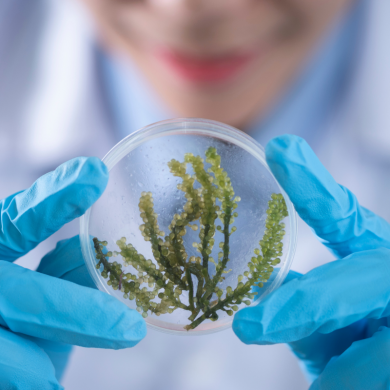Simply explained: nitrogen cycle in reef tanks

The nitrogen cycle - what is that actually? We will explain everything you need to know about it as a reef hobbyist
One of the most important cycles in your reef aquarium is the nitrogen cycle. Nitrogen (N2) is a basic component of many biomolecules and occurs in proteins and amino acids, for example.
The algae in your aquarium use inorganic nitrogen compounds to build and grow biomass. If fish or other reef inhabitants eat these algae, the N-compounds they contain are broken down and the excess nitrogen is released into the environment in the form of ammonia ((NH3), ammonium (NH4+), urea (CH4N2O) or uric acid (C5H4N4O3). These are therefore the preliminary end products or waste products that cannot be further utilized by the organisms.
Bacteria now begin to convert the excreted nitrogen compounds into inorganic compounds. They do this in order to access the carbon contained in the organic compounds. The resulting inorganic nutrients are now available to algae and corals, which means that the nitrogen cycle is largely closed.
Nitrification vs. denitrification
Within the nitrogen cycle, two metabolic pathways carried out by bacteria are of particular importance for your reef aquarium. These are nitrification and denitrification.
In the course of the nitrification ammonium (NH4+) is converted via nitrite (NO2-) to nitrate (NO3-). This reaction is mainly performed by the two bacteria Nitrosomonas and Nitrobacter in the presence of oxygen. This is therefore called oxidation.
The nitrate formed during nitrification is converted to molecular nitrogen (N2) during denitrification. This reaction is a so-called reduction. It can only take place in the absence of oxygen, i.e. under anoxic conditions.
Ammonium vs. ammonia
The conversion of ammonium to nitrate is of great importance because ammonium can change into toxic ammonia depending on the existing pH value, whereas nitrate is harmless.
Ammonia is toxic to almost all organisms in your reef aquarium. The actual concentration of ammonia can be calculated indirectly via the pH value and the ammonium concentration. The concentration of ammonia must not exceed 0.01 mg/l. The ammonium content should also not be higher than 0.1 mg/l.
Nitrite
The oxidation of ammonium produces nitrite. Although this is less dangerous than ammonia in seawater, it is still considered a toxic compound whose concentration should not exceed 1 mg/l.
This is especially true for fish, as nitrite oxidizes the iron contained in the red blood pigment hemoglobin, which has a negative effect on the transport of vital oxygen (O2).
However, high nitrite concentrations are less harmful in saltwater aquariums than in freshwater. This is due to the fact that the chloride ions (Cl-) contained in seawater compete with the nitrite molecules at the gills of the fish for uptake into the blood. Since the concentration of chloride ions is much higher, less nitrite is absorbed into the blood of the fish.
Nitrate
The oxidation of nitrite produces nitrate. Although this is not dangerous for the organisms in your reef aquarium, it can easily be absorbed by algae and can therefore lead to unwanted and excessive algae growth.
This is also true for the zooxanthellae of your corals. Due to the increased nitrate concentrations they start to multiply quickly and compete with the coral for important substances and compounds. This ultimately leads to the fact that your corals grow more slowly and their tissue becomes increasingly brown.
To counteract this, it is advisable to remove or reduce the nitrate that accumulates in the aquarium so that its value does not exceed a concentration of 5 to 10 mg/l.
As already described, the nitrate can be converted into molecular atmospheric nitrogen by means of so-called denitrification under anoxic conditions. This process takes place inside your living rock, for example, while nitrification processes take place on the surface.
Factors influencing the nitrogen cycle
First of all, the type and number of bacteria is crucial for a functioning cycle. Bacterial supplements, such as Tropic Marin Nitribiotic, can help to accelerate or support the nitrogen cycle. A fine-pored filter material offers a particularly large settlement area and promotes the development of a large bacterial population. The oxygen supply also plays a major role. The aeration or flushing of the filter material or the soil should be checked regularly and adjusted if necessary. You can also increase the bacterial activity by feeding the bacteria. Examples for bacterial food are various carbon sources, like ethanol (keyword "vodka method") or commercial products, like the Tropic Marin Elimi-Phos.